Chapter 6 Application Of Derivatives
APPLICATION OF DERIVATIVES
With the Calculus as a key, Mathematics can be successfully applied to the explanation of the course of Nature." - WHITEHEAD
6.1 Introduction
In Chapter 5, we have learnt how to find derivative of composite functions, inverse trigonometric functions, implicit functions, exponential functions and logarithmic functions. In this chapter, we will study applications of the derivative in various disciplines, e.g., in engineering, science, social science, and many other fields. For instance, we will learn how the derivative can be used (i) to determine rate of change of quantities, (ii) to find the equations of tangent and normal to a curve at a point, (iii) to find turning points on the graph of a function which in turn will help us to locate points at which largest or smallest value (locally) of a function occurs. We will also use derivative to find intervals on which a function is increasing or decreasing. Finally, we use the derivative to find approximate value of certain quantities.
6.2 Rate of Change of Quantities
Recall that by the derivative $\\ \frac{ds}{dt} $, we mean the rate of change of distance $s$ with respect to the time $t$. In a similar fashion, whenever one quantity $y$ varies with another quantity $x$, satisfying some rule $y=f(x)$, then $\frac{d y}{d x}$ (or $f^{\prime}(x)$ ) represents the rate of change of $y$ with respect to $x$ and $\frac{d y}{d x} _{x=x_0}(.$ or $.f^{\prime}(x_0))$ represents the rate of change of $y$ with respect to $x$ at $x=x_0$.
Further, if two variables $x$ and $y$ are varying with respect to another variable $t$, i.e., if $x=f(t)$ and $y=g(t)$, then by Chain Rule
$ \frac{d y}{d x}=\frac{d y}{d t} / \frac{d x}{d t}, \text{ if } \frac{d x}{d t} \neq 0 $
Thus, the rate of change of $y$ with respect to $x$ can be calculated using the rate of change of $y$ and that of $x$ both with respect to $t$.
Let us consider some examples.
6.3 Increasing and Decreasing Functions
In this section, we will use differentiation to find out whether a function is increasing or decreasing or none.
Consider the function $f$ given by $f(x)=x^{2}, x \in \mathbf{R}$. The graph of this function is a parabola as given in Fig 6.1.
Values left to origin
| x | $ f(x)=x^2 $ |
|---|---|
| -2 | 4 |
| $ -\frac{3}{2} $ | $ \frac{9}{4} $ |
| -1 | 1 |
| $ -\frac{1}{2} $ | $ \frac{4}{4} $ |
| 0 | 0 |
as we move from left to right, the height of the graph decreases
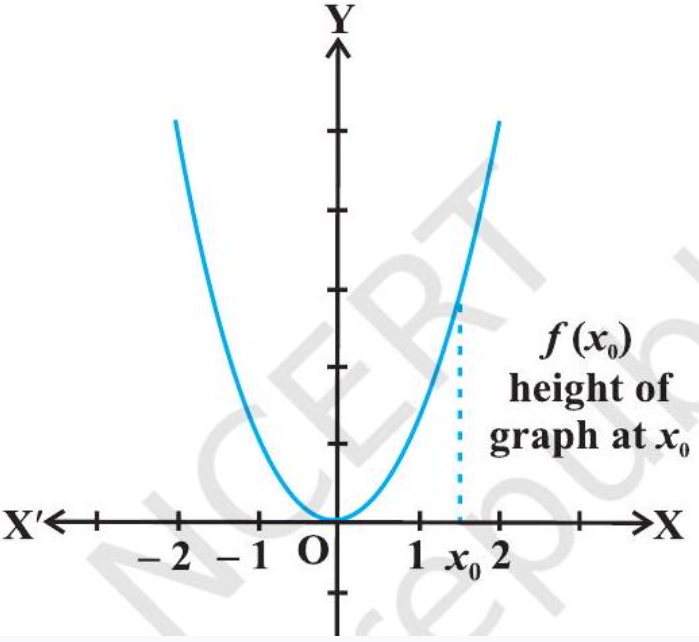
as we move from left to right, the height of the graph increases
Values right to origin
| x | $ f(x)=x^2 $ |
|---|---|
| 0 | 0 |
| $ \frac{1}{4} $ | $ \frac{1}{4} $ |
| 1 | 1 |
| $ \frac{3}{2} $ | $ \frac{9}{4} $ |
| 2 | 4 |
Fig 6.1
First consider the graph (Fig 6.1) to the right of the origin. Observe that as we move from left to right along the graph, the height of the graph continuously increases. For this reason, the function is said to be increasing for the real numbers $x>0$.
Now consider the graph to the left of the origin and observe here that as we move from left to right along the graph, the height of the graph continuously decreases. Consequently, the function is said to be decreasing for the real numbers $x<0$.
We shall now give the following analytical definitions for a function which is increasing or decreasing on an interval.
Definition 1 Let I be an interval contained in the domain of a real valued function $f$. Then $f$ is said to be
(i) increasing on I if $x_1<x_2$ in $I \Rightarrow f(x_1)<f(x_2)$ for all $x_1, x_2 \in I$.
(ii) decreasing on $I$, if $x_1, x_2$ in $I \Rightarrow f(x_1)<f(x_2)$ for all $x_1, x_2 \in I$.
(iii) constant on $I$, if $f(x)=c$ for all $x \in I$, where $c$ is a constant. (iv) decreasing on I if $x_1<x_2$ in $I \Rightarrow f(x_1) \geq f(x_2)$ for all $x_1, x_2 \in I$.
(v) strictly decreasing on I if $x_1<x_2$ in $I \Rightarrow f(x_1)>f(x_2)$ for all $x_1, x_2 \in I$.
For graphical representation of such functions see Fig 6.2.
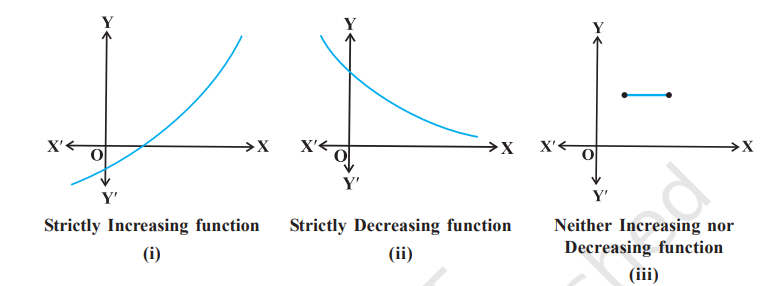
Fig 6.2
We shall now define when a function is increasing or decreasing at a point.
Definition 2 Let $x_0$ be a point in the domain of definition of a real valued function $f$. Then $f$ is said to be increasing, decreasing at $x_0$ if there exists an open interval I containing $x_0$ such that $f$ is increasing, decreasing, respectively, in I.
Let us clarify this definition for the case of increasing function.
Theorem 1 Let $f$ be continuous on $[a, b]$ and differentiable on the open interval $(a, b)$. Then
(a) $f$ is increasing in $[a, b]$ if $f^{\prime}(x)>0$ for each $x \in(a, b)$
(b) $f$ is decreasing in $[a, b]$ if $f^{\prime}(x)<0$ for each $x \in(a, b)$
(c) $f$ is a constant function in $[a, b]$ if $f^{\prime}(x)=0$ for each $x \in(a, b)$
Proof (a) Let $x_1, x_2 \in[a, b]$ be such that $x_1<x_2$.
Then, by Mean Value Theorem (Theorem 8 in Chapter 5), there exists a point $c$ between $x_1$ and $x_2$ such that
i.e.
$ f(x_2)-f(x_1)=f^{\prime}(c)(x_2-x_1) $
i.e.
$ f(x_2)-f(x_1)>0 \quad(\text{ as } f^{\prime}(c)>0 \text{ (given) }) $
Thus, we have
$ f(x_2)>f(x_1) $
$ x_1<x_2 \quad f(x_1) \quad f(x_2), \text{ for all } x_1, x_2 \quad[a, b] $
Hence, $f$ is an increasing function in $[a, b]$.
The proofs of part (b) and (c) are similar. It is left as an exercise to the reader.
Remarks
There is a more generalised theorem, which states that if $f \phi(x)>0$ for $x$ in an interval excluding the end points and $f$ is continuous in the interval, then $f$ is increasing. Similarly, if $f \phi(x)<0$ for $x$ in an interval excluding the end points and $f$ is continuous in the interval, then $f$ is decreasing.
6.4 Maxima and Minima
In this section, we will use the concept of derivatives to calculate the maximum or minimum values of various functions. In fact, we will find the ’turning points’ of the graph of a function and thus find points at which the graph reaches its highest (or lowest) locally. The knowledge of such points is very useful in sketching the graph of a given function. Further, we will also find the absolute maximum and absolute minimum of a function that are necessary for the solution of many applied problems.
Let us consider the following problems that arise in day to day life.
(i) The profit from a grove of orange trees is given by $P(x)=a x+b x^{2}$, where $a, b$ are constants and $x$ is the number of orange trees per acre. How many trees per acre will maximise the profit?
(ii) A ball, thrown into the air from a building 60 metres high, travels along a path given by $h(x)=60+x-\frac{x^{2}}{60}$, where $x$ is the horizontal distance from the building and $h(x)$ is the height of the ball . What is the maximum height the ball will reach?
(iii) An Apache helicopter of enemy is flying along the path given by the curve $f(x)=x^{2}+7$. A soldier, placed at the point $(1,2)$, wants to shoot the helicopter when it is nearest to him. What is the nearest distance?
In each of the above problem, there is something common, i.e., we wish to find out the maximum or minimum values of the given functions. In order to tackle such problems, we first formally define maximum or minimum values of a function, points of local maxima and minima and test for determining such points.
Definition 3 Let $f$ be a function defined on an interval I. Then
(a) $f$ is said to have a maximum value in I, if there exists a point $c$ in I such that $f(c)>f(x)$, for all $x \in I$.
The number $f(c)$ is called the maximum value of $f$ in I and the point $c$ is called a point of maximum value of $f$ in $I$.
(b) $f$ is said to have a minimum value in $I$, if there exists a point $c$ in $I$ such that $f(c)<f(x)$, for all $x \in I$.
The number $f(c)$, in this case, is called the minimum value of $f$ in I and the point $c$, in this case, is called a point of minimum value of $f$ in $I$.
(c) $f$ is said to have an extreme value in $I$ if there exists a point $c$ in I such that $f(c)$ is either a maximum value or a minimum value of $f$ in $I$.
The number $f(c)$, in this case, is called an extreme value of $f$ in $I$ and the point $c$ is called an extreme point.
Remark In Fig 6.7(a), (b) and (c), we have exhibited that graphs of certain particular functions help us to find maximum value and minimum value at a point. Infact, through graphs, we can even find maximum/minimum value of a function at a point at which it is not even differentiable (Example 15 ).
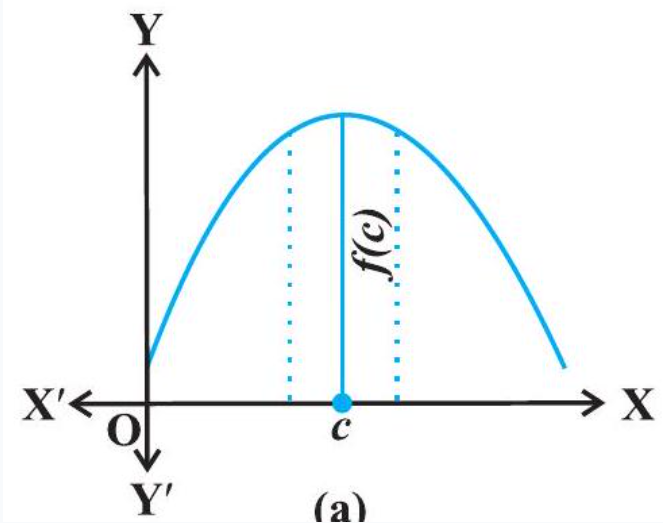
(a)
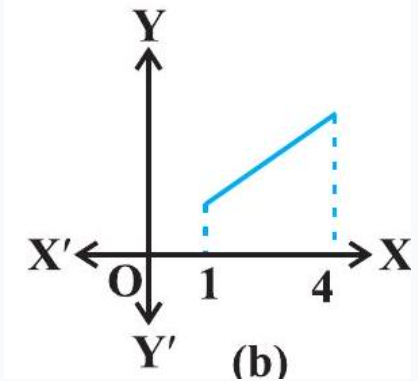 (b)
(b)
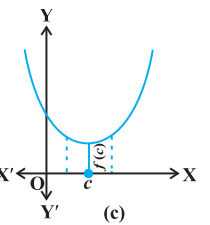
(c)
Fig 6.7
Note
(i) If we restrict the domain of $f$ to $[-2,1]$ only, then $f$ will have maximum value $|-2|=2$.
(ii) One may note that the function $f$ in Example 27 is not differentiable at $x=0$.
Remark The reader may observe that in Example 16 **, if we include the points 0 and 1 in the domain of $f$, i.e., if we extend the domain of $f$ to $[0,1]$, then the function $f$ has minimum value 0 at $x=0$ and maximum value 1 at $x=1$. Infact, we have the following results (The proof of these results are beyond the scope of the present text)
Every monotonic function assumes its maximum/minimum value at the end points of the domain of definition of the function.
A more general result is
Every continuous function on a closed interval has a maximum and a minimum value.
Note By a monotonic function $f$ in an interval $I$, we mean that $f$ is either increasing in I or decreasing in I.
Maximum and minimum values of a function defined on a closed interval will be discussed later in this section.
Let us now examine the graph of a function as shown in Fig 6.11. Observe that at points $A, B, C$ and $D$ on the graph, the function changes its nature from decreasing to increasing or vice-versa. These points may be called turning points of the given function. Further, observe that at turning points, the graph has either a little hill or a little valley. Roughly speaking, the function has minimum value in some neighbourhood (interval) of each of the points $A$ and $C$ which are at the bottom of their respective
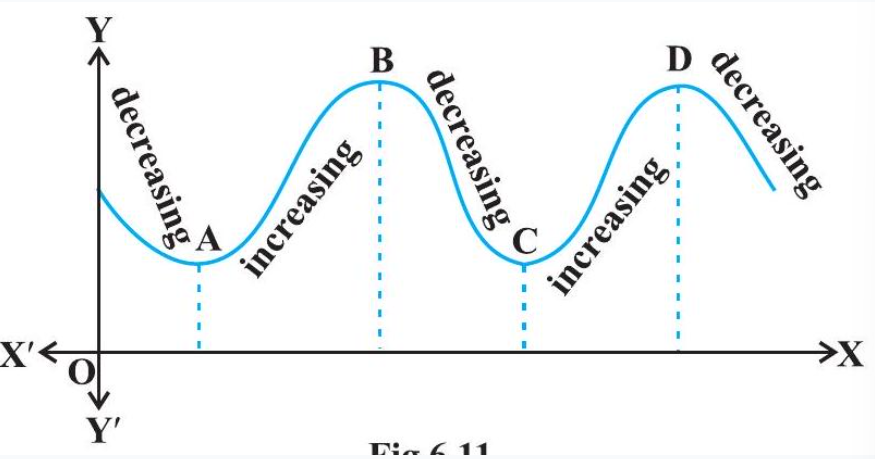
Fig 6.11
valleys. Similarly, the function has maximum value in some neighbourhood of points B and $D$ which are at the top of their respective hills. For this reason, the points $A$ and $C$ may be regarded as points of local minimum value (or relative minimum value) and points $B$ and $D$ may be regarded as points of local maximum value (or relative maximum value) for the function. The local maximum value and local minimum value of the function are referred to as local maxima and local minima, respectively, of the function.
We now formally give the following definition
Definition 4 Let $f$ be a real valued function and let $c$ be an interior point in the domain of $f$. Then
(a) $c$ is called a point of local maxima if there is an $h>0$ such that
$ f(c) \geq f(x) \text{, for all } x \text{ in }(c-h, c+h), x \neq c $
The value $f(c)$ is called the local maximum value of $f$.
(b) $c$ is called a point of local minima if there is an $h>0$ such that
$ f(c) \leq f(x) \text{, for all } x \text{ in }(c-h, c+h) $
The value $f(c)$ is called the local minimum value of $f$.
Geometrically, the above definition states that if $x=c$ is a point of local maxima of $f$, then the graph of $f$ around $c$ will be as shown in Fig 6.12(a). Note that the function $f$ is increasing (i.e., $.f^{\prime}(x)>0)$ in the interval $(c-h, c)$ and decreasing (i.e., $.f^{\prime}(x)<0)$ in the interval $(c, c+h)$.
This suggests that $f^{\prime}(c)$ must be zero.
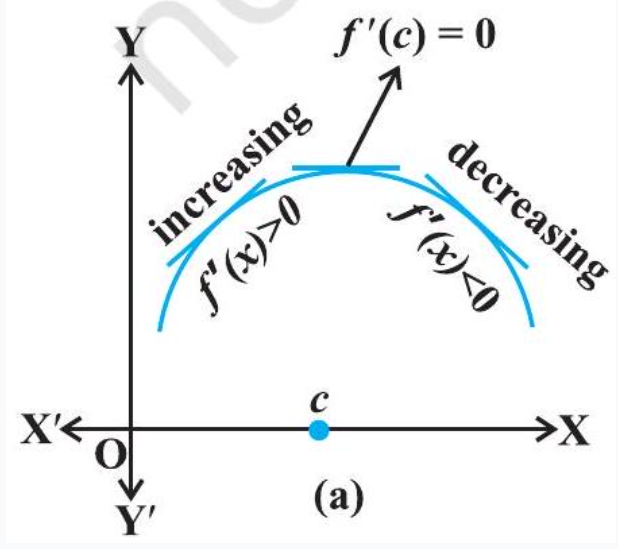
Fig 6.12
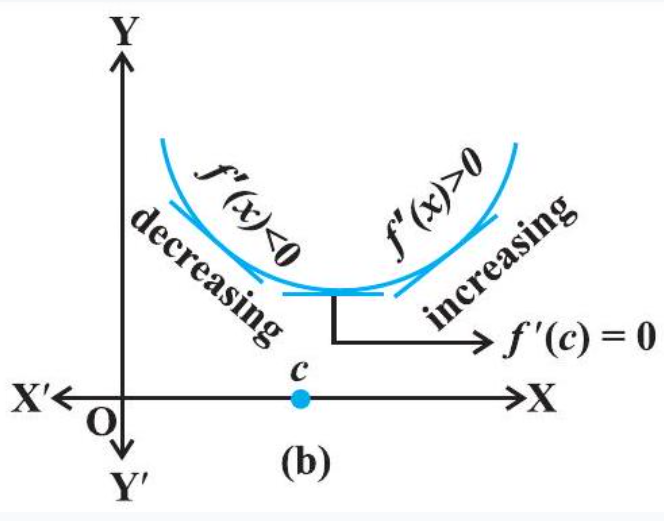
Similarly, if $c$ is a point of local minima of $f$, then the graph of $f$ around $c$ will be as shown in Fig 6.14(b). Here $f$ is decreasing (i.e., $.f^{\prime}(x)<0)$ in the interval $(c-h, c)$ and increasing (i.e., $.f^{\prime}(x)>0)$ in the interval $(c, c+h)$. This again suggest that $f^{\prime}(c)$ must be zero.
The above discussion lead us to the following theorem (without proof).
Theorem 2 Let $f$ be a function defined on an open interval I. Suppose $c \in I$ be any point. If $f$ has a local maxima or a local minima at $x=c$, then either $f^{\prime}(c)=0$ or $f$ is not differentiable at $c$.
Remark The converse of above theorem need not be true, that is, a point at which the derivative vanishes need not be a point of local maxima or local minima. For example, if $f(x)=x^{3}$, then $f^{\prime}(x)=3 x^{2}$ and so $f^{\prime}(0)=0$. But 0 is neither a point of local maxima nor a point of local minima (Fig 6.13).
Note A point $c$ in the domain of a function $f$ at which either $f^{\prime}(c)=0$ or $f$ is not differentiable is called a critical point of $f$. Note that if $f$ is continuous at $c$ and $f^{\prime}(c)=0$, then there exists an $h>0$ such that $f$ is differentiable in the interval $(c-h, c+h)$.
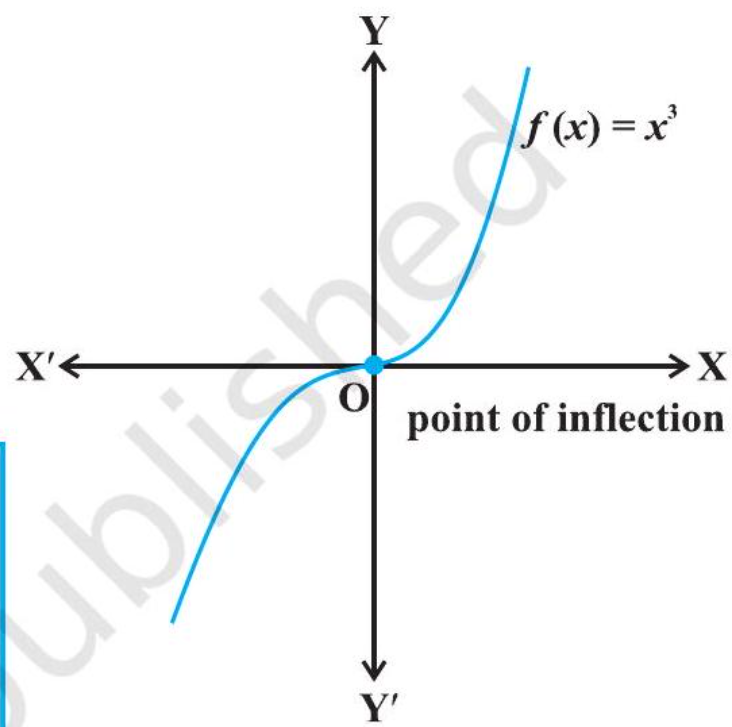
Fig 6.13
We shall now give a working rule for finding points of local maxima or points of local minima using only the first order derivatives.
Theorem 3 (First Derivative Test) Let $f$ be a function defined on an open interval I. Let $f$ be continuous at a critical point $c$ in I. Then
(i) If $f^{\prime}(x)$ changes sign from positive to negative as $x$ increases through $c$, i.e., if $f^{\prime}(x)>0$ at every point sufficiently close to and to the left of $c$, and $f^{\prime}(x)<0$ at every point sufficiently close to and to the right of $c$, then $c$ is a point of local maxima.
(ii) If $f^{\prime}(x)$ changes sign from negative to positive as $x$ increases through $c$, i.e., if $f^{\prime}(x)<0$ at every point sufficiently close to and to the left of $c$, and $f^{\prime}(x)>0$ at every point sufficiently close to and to the right of $c$, then $c$ is a point of local minima.
(iii) If $f^{\prime}(x)$ does not change sign as $x$ increases through $c$, then $c$ is neither a point of local maxima nor a point of local minima. Infact, such a point is called point of inflection (Fig 6.13).
Note If $c$ is a point of local maxima of $f$, then $f(c)$ is a local maximum value of $f$. Similarly, if $c$ is a point of local minima of $f$, then $f(c)$ is a local minimum value of $f$.
Figures 6.13 and 6.14, geometrically explain Theorem 3.
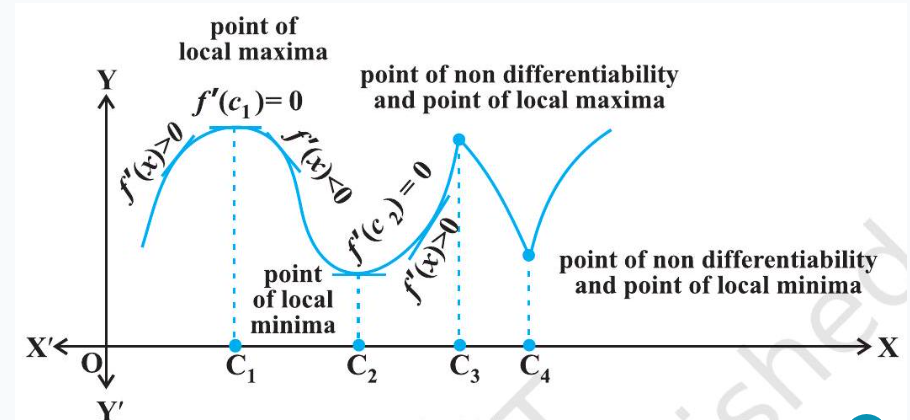
Fig 6.14
Remark One may note that since $f^{\prime}(x)$, in Example 30 , never changes its sign on $\mathbf{R}$, graph of $f$ has no turning points and hence no point of local maxima or local minima.
We shall now give another test to examine local maxima and local minima of a given function. This test is often easier to apply than the first derivative test.
Theorem 4 (Second Derivative Test) Let $f$ be a function defined on an interval I and $c \in I$. Let $f$ be twice differentiable at $c$. Then
(i) $x=c$ is a point of local maxima if $f^{\prime}(c)=0$ and $f^{\prime \prime}(c)<0$
The value $f(c)$ is local maximum value of $f$.
(ii) $x=c$ is a point of local minima if $f^{\prime}(c)=0$ and $f^{\prime \prime}(c)>0$
In this case, $f(c)$ is local minimum value of $f$.
(iii) The test fails if $f^{\prime}(c)=0$ and $f^{\prime \prime}(c)=0$.
In this case, we go back to the first derivative test and find whether $c$ is a point of local maxima, local minima or a point of inflexion.
Note As $f$ is twice differentiable at $c$, we mean second order derivative of $f$ exists at $c$.
Remark Proceeding as in Example 34 one may prove that the two positive numbers, whose sum is $k$ and the sum of whose squares is minimum, are $\frac{k}{2}$ and $\frac{k}{2}$.
6.4.1 Maximum and Minimum Values of a Function in a Closed Interval
Let us consider a function $f$ given by
$ f(x)=x+2, x \in(0,1) $
Observe that the function is continuous on $(0,1)$ and neither has a maximum value nor has a minimum value. Further, we may note that the function even has neither a local maximum value nor a local minimum value.
However, if we extend the domain of $f$ to the closed interval $[0,1]$, then $f$ still may not have a local maximum (minimum) values but it certainly does have maximum value $3=f(1)$ and minimum value $2=f(0)$. The maximum value 3 of $f$ at $x=1$ is called absolute maximum value (global maximum or greatest value) of $f$ on the interval $[0,1]$. Similarly, the minimum value 2 of $f$ at $x=0$ is called the absolute minimum value (global minimum or least value) of $f$ on $[0,1]$.
Consider the graph given in Fig 6.19 of a continuous function defined on a closed interval $[a, d]$. Observe that the function $f$ has a local minima at $x=b$ and local
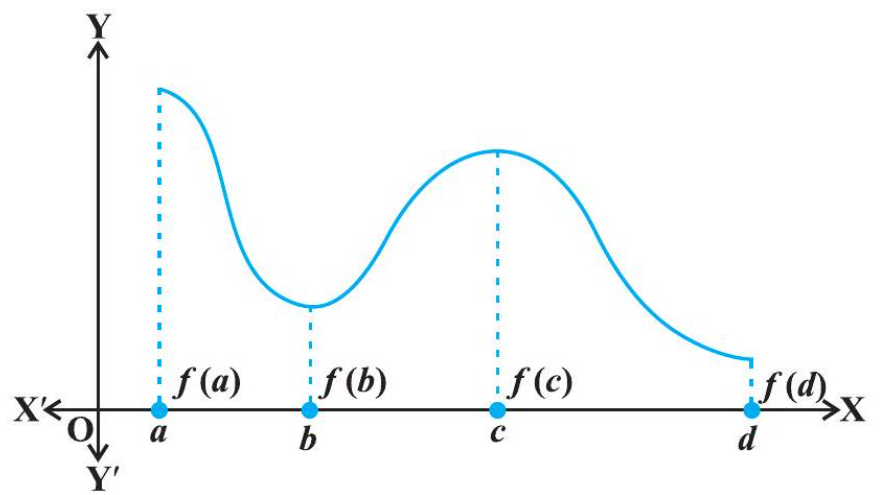
Fig 6.19
minimum value is $f(b)$. The function also has a local maxima at $x=c$ and local maximum value is $f(c)$.
Also from the graph, it is evident that $f$ has absolute maximum value $f(a)$ and absolute minimum value $f(d)$. Further note that the absolute maximum (minimum) value of $f$ is different from local maximum (minimum) value of $f$.
We will now state two results (without proof) regarding absolute maximum and absolute minimum values of a function on a closed interval I.
Theorem 5 Let $f$ be a continuous function on an interval $I=[a, b]$. Then $f$ has the absolute maximum value and $f$ attains it at least once in I. Also, $f$ has the absolute minimum value and attains it at least once in $I$.
Theorem 6 Let $f$ be a differentiable function on a closed interval I and let $c$ be any interior point of I. Then
(i) $f^{\prime}(c)=0$ if $f$ attains its absolute maximum value at $c$.
(ii) $f^{\prime}(c)=0$ if $f$ attains its absolute minimum value at $c$.
In view of the above results, we have the following working rule for finding absolute maximum and/or absolute minimum values of a function in a given closed interval $[a, b]$.
Working Rule
Step 1: Find all critical points of $f$ in the interval, i.e., find points $x$ where either $f^{\prime}(x)=0$ or $f$ is not differentiable.
Step 2: Take the end points of the interval.
Step 3: At all these points (listed in Step 1 and 2), calculate the values of $f$.
Step 4: Identify the maximum and minimum values of $f$ out of the values calculated in Step 3. This maximum value will be the absolute maximum (greatest) value of $f$ and the minimum value will be the absolute minimum (least) value of $f$.
Summary
If a quantity y varies with another quantity x, satisfying some rule y= f(x),then $ \frac{dy}{dx}or (f’(x)) $ represents the rate of change of y with tespect to x and $ \frac{dy}dx _{x=x0} or(f’(x_0))$\ text{represents the rate of change of y with respect to x at}$ $ x=x+0 $ $
If two variables $x$ and $y$ are varying with respect to another variable $t$, i.e., if $x=f(t)$ and $y=g(t)$, then by Chain Rule
$ \frac{d y}{d x}=\frac{d y}{d t} / \frac{d x}{d t}, \text{ if } \frac{d x}{d t} \neq 0 . $
A function $f$ is said to be
(a) increasing on an interval $(a, b)$ if $x_1<x_2$ in $(a, b) \Rightarrow f(x_1)<f(x_2)$ for all $x_1, x_2 \in(a, b)$.
Alternatively, if $f^{\prime}(x) \geq 0$ for each $x$ in $(a, b)$
(b) decreasing on $(a, b)$ if
$ x_1<x_2 \text{ in }(a, b) \Rightarrow f(x_1)>f(x_2) \text{ for all } x_1, x_2 \in(a, b) \text{. } $
(c) constant in $(a, b)$, if $f(x)=c$ for all $x \in(a, b)$, where $c$ is a constant.
- A point $c$ in the domain of a function $f$ at which either $f^{\prime}(c)=0$ or $f$ is not differentiable is called a critical point of $f$.
- First Derivative Test Let $f$ be a function defined on an open interval I. Let $f$ be continuous at a critical point $c$ in $I$. Then
(i) If $f^{\prime}(x)$ changes sign from positive to negative as $x$ increases through $c$, i.e., if $f^{\prime}(x)>0$ at every point sufficiently close to and to the left of $c$, and $f^{\prime}(x)<0$ at every point sufficiently close to and to the right of $c$, then $c$ is a point of local maxima. (ii) If $f^{\prime}(x)$ changes sign from negative to positive as $x$ increases through $c$, i.e., if $f^{\prime}(x)<0$ at every point sufficiently close to and to the left of $c$, and $f^{\prime}(x)>0$ at every point sufficiently close to and to the right of $c$, then $c$ is a point of local minima.
(iii) If $f^{\prime}(x)$ does not change sign as $x$ increases through $c$, then $c$ is neither a point of local maxima nor a point of local minima. Infact, such a point is called point of inflexion.
Second Derivative Test Let $f$ be a function defined on an interval I and $c \in I$. Let $f$ be twice differentiable at $c$. Then
(i) $x=c$ is a point of local maxima if $f^{\prime}(c)=0$ and $f^{\prime \prime}(c)<0$
The values $f(c)$ is local maximum value of $f$.
(ii) $x=c$ is a point of local minima if $f^{\prime}(c)=0$ and $f^{\prime \prime}(c)>0$
In this case, $f(c)$ is local minimum value of $f$.
(iii) The test fails if $f^{\prime}(c)=0$ and $f^{\prime \prime}(c)=0$.
In this case, we go back to the first derivative test and find whether $c$ is a point of maxima, minima or a point of inflexion.
Working rule for finding absolute maxima and/or absolute minima
Step 1: Find all critical points of $f$ in the interval, i.e., find points $x$ where either $f^{\prime}(x)=0$ or $f$ is not differentiable.
Step 2:Take the end points of the interval.
Step 3: At all these points (listed in Step 1 and 2), calculate the values of $f$.
Step 4: Identify the maximum and minimum values of $f$ out of the values calculated in Step 3. This maximum value will be the absolute maximum value of $f$ and the minimum value will be the absolute minimum value of $f$.






